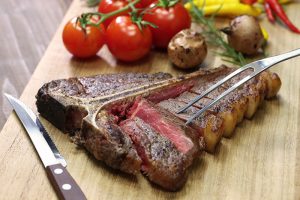“Grass fed grain finished beef” produces the highest nutritional value with the best flavor. Grain-finished beef tends to be milder in flavor compared to grass-finished – both being higher in nutritional value over standard-issue supermarket grain-fed beef. Supermarket beef cattle are fed a combination of corn (husks and cobs), soy and other supplements for 3-6 months before harvest; a mix that has been fine-tuned to promote faster growth. The corn leads to higher-level of marbling and gives the meat a slightly sweeter taste.
Why “Grass Fed Grain Finished Beef” Tastes so Good
Ozark Prime Beef cattle are grass fed, grain finished – which means they feed on grass and other plants that grow naturally in the pasture. This gives the meat more of a “meatier” taste with less marbling, so cattle are finished with grain prior to harvest. This practice produces that “sweet spot” to deliver the flavor most beef-lovers crave, without compromising the nutritional value or quality. Higher levels of omega-3 acids, greater amounts of conjugated linoleic acid (CLA), and fewer calories per-pound are the three main reasons our grass-fed, grain-finished beef is healthier. The steaks tend to be richer in both taste and texture with balanced marbling. It is that balanced marbling that keeps the beef healthier without reducing the richness of flavor steak-lovers look for.
Why “Grass Fed Grain Finished Beef” is Healthier
 The fact is, most Americans prefer the taste of grain-fed, supermarket steak and particularly the prized, high-dollar corn-fed steaks served in restaurants. Enjoying the very thing that gives steak flavor – marbling (fat content) – is also what reduces the nutritional and health value of beef. What and how cattle are fed has a major effect on the nutrient composition of the beef. Mass-produced beef from cattle confined and rapidly fattened up with grain-based feeds delivers quite a different result. Months of living in a feedlot, being treated with antibiotics and injected with growth hormones, is not the way cattle should be treated, in our humble opinion. The fact that it produces beef of lesser quality and nutritional value is not a surprise.
The fact is, most Americans prefer the taste of grain-fed, supermarket steak and particularly the prized, high-dollar corn-fed steaks served in restaurants. Enjoying the very thing that gives steak flavor – marbling (fat content) – is also what reduces the nutritional and health value of beef. What and how cattle are fed has a major effect on the nutrient composition of the beef. Mass-produced beef from cattle confined and rapidly fattened up with grain-based feeds delivers quite a different result. Months of living in a feedlot, being treated with antibiotics and injected with growth hormones, is not the way cattle should be treated, in our humble opinion. The fact that it produces beef of lesser quality and nutritional value is not a surprise.
Cattle that freely roam the pasture and live the way nature intended produce meat that gram-for-gram contains fewer calories. The composition of fatty acids is also different. Monosaturated fat is less than that of grain-fed beef, whereas Omega-3s are up to five times higher and CLA is about twice as high. The breed and type of meat cut can also make a considerable difference in the fat composition of beef.
All beef is loaded with vitamin B12, B3, B6, iron, selenium, and zinc – almost every nutrient humans need to survive. Beef also contains high-quality protein and some lesser known nutrients like creatine and carnosine that your muscles and brain need for good health. Grass-fed beef generally has higher amounts of certain nutrients such as Vitamin A and Vitamin E. Carotenoid precursors to vitamin A such as beta-carotene, and antioxidants are richer in grass-fed beef. What many people do not realize is that overcooking beef can lead to the formation of harmful compounds, negating some of the health benefits of eating beef in moderation for a balanced diet.
While it may be true grass-fed beef contains higher amounts of certain nutrients, experts argue there is no compelling evidence it is significantly healthier than grain-fed beef in the context of a balanced diet. Despite all the opinions, those who only eat real food that eats real food choose beef from a trusted source.

